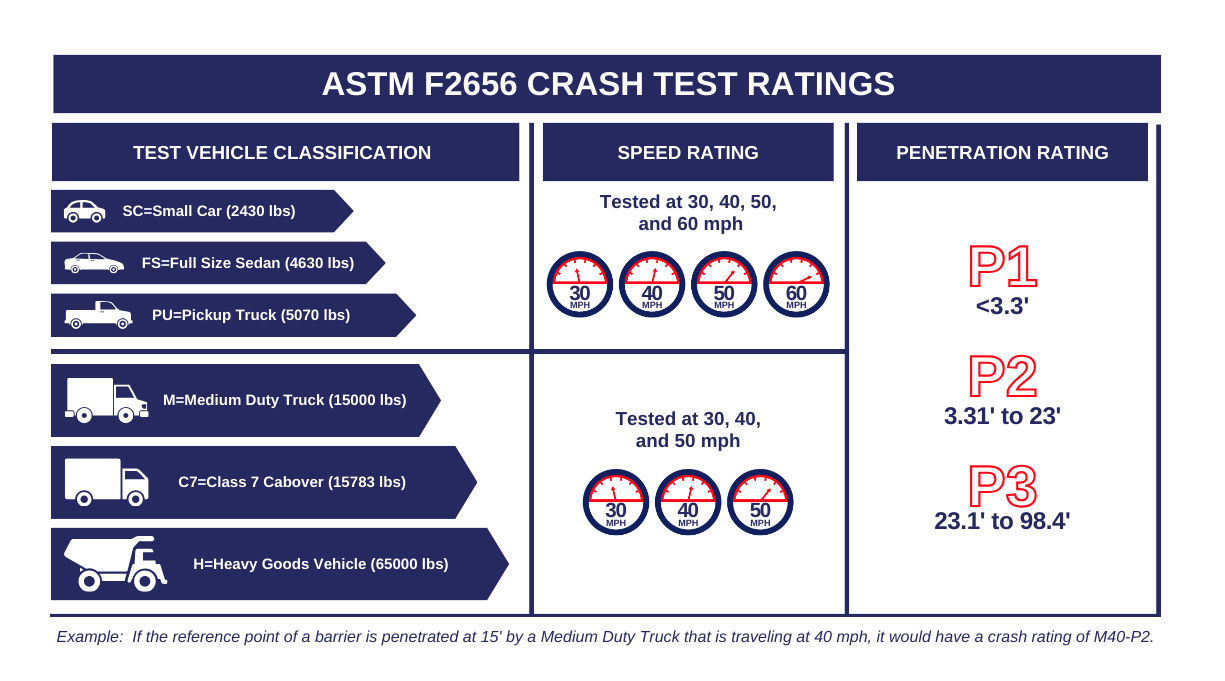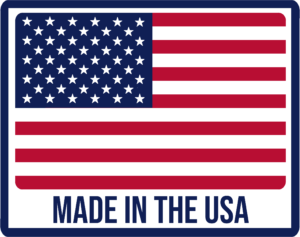ASTM Crash Ratings
ASTM F2656 Crash Ratings Explained
The ASTM F2656 standard was created to replace the old Department of State crash testing standard (K-ratings). It was designed to meet the needs of various organizations responsible for protecting U.S. assets both in the country and abroad. To address this need, ASTM developed the F2656 “Standard Test Method for Crash Testing of Vehicle Security Barriers.”
The ratings in ASTM F2656 are based on three main factors:
1) type of vehicle used in the test
2) speed of the vehicle during the test
3) how much the vehicle penetrates the barrier during the test.
There are six classes of vehicles used in the testing: Small Car (SC), Full-Size Sedan (FS), Pickup Truck (PU), Medium Duty Truck (M), Class 7 Cabover (C7), and Heavy Goods Vehicle (H). The lighter vehicles (SC, FS, PU) are tested at speeds of 30, 40, 50, and 60 mph, while the heavier vehicles (M, C7, H) are tested at 30, 40, and 50 mph.
The penetration ratings (P-ratings) define how far the vehicle penetrates the reference point on the barrier. A P1 rating is given for penetration of 3.3 ft (1m) or less, P2 for penetration greater than 3.3 ft (1m) up to 23 ft (7m), P3 for penetration greater than 23 ft (7m) up to 98.4 ft (30m), and a failure for any penetration beyond 98.4 ft (30m). 
ASTM F3016 Crash Ratings Explained
To address lower speed crash testing methods, ASTM developed the F3016 “Standard Test Method for Surrogate Testing of Vehicle Impact Protective Devices at Low Speeds.”
The surrogate test vehicle for ASTM F3016 weighs 5,000 lbs and is designed to mimic the crash performance of a full-size pickup truck or SUV. Tests are conducted at speeds of 10, 20, and 30 mph.
The test measures penetration from the first impact point on the barrier. Any part of the test vehicle that moves past this point determines the dynamic penetration of the test.
The P-ratings used in ASTM F3016 are similar to those in ASTM F2656. A P1 rating is given for penetration of 1 ft (0.3m) or less, P2 for penetration greater than 1 ft (0.3m) up to 4 ft (1.22m), and a failure for any penetration beyond 4 ft (1.22m).
ASTM F3016 is used for products intended for storefront applications, where there is little space between the barrier and the sidewalk or store entrance. These crash-tested products are suitable for locations where vehicles might impact areas where people work, shop, play, or eat.

Department of State K-Ratings Explained
Established in 1985, the Department of State’s K ratings played a crucial role in guiding the selection and deployment of anti-ram vehicle barriers at government facilities and other critical infrastructure sites worldwide. However, as security standards evolved, these ratings were gradually replaced by more comprehensive and internationally recognized standards, such as those developed by ASTM International, to ensure consistent and reliable protection against emerging threats.
The Department of State K ratings and the ASTM M ratings both indicate the effectiveness of anti-ram vehicle barriers in stopping a 15,000 lb vehicle. Under the Department of State’s classifications, K12 and its ASTM counterpart, M50, signify a barrier’s capability of halting a 15,000 lb vehicle traveling at 50 mph. Similarly, K8, now mirrored by M40, denotes a barrier’s capability of stopping the same vehicle at 40 mph. Finally, what was previously classified as K4, now categorized as M30, indicates a barrier’s capability of stopping a 15,000 lb vehicle at 30 mph.
Through rigorous testing procedures simulating real-world scenarios, such as vehicle impacts at varying speeds and angles, both Department of State K ratings and ASTM M ratings offer comprehensive assessments of barrier performance.
ASTM Crash Ratings for Barrier1 Products
Barrier1 products are rigorously tested to meet ASTM F2656 and ASTM F3016 crash ratings, ensuring top-notch security against vehicle impacts. These standards evaluate the strength and durability of security barriers. The following chart provides a comprehensive list of our products along with their respective ASTM ratings, helping you choose the most suitable barrier for your specific needs.

For more detailed information on the ASTM F2656 and F3016 guidelines, please visit the ASTM International website using the following links:

